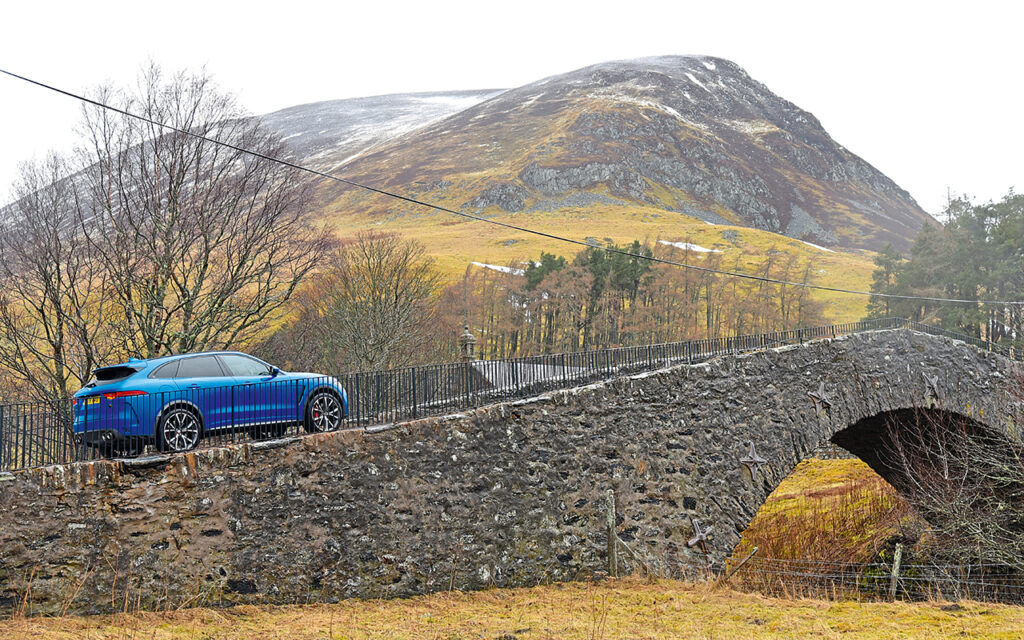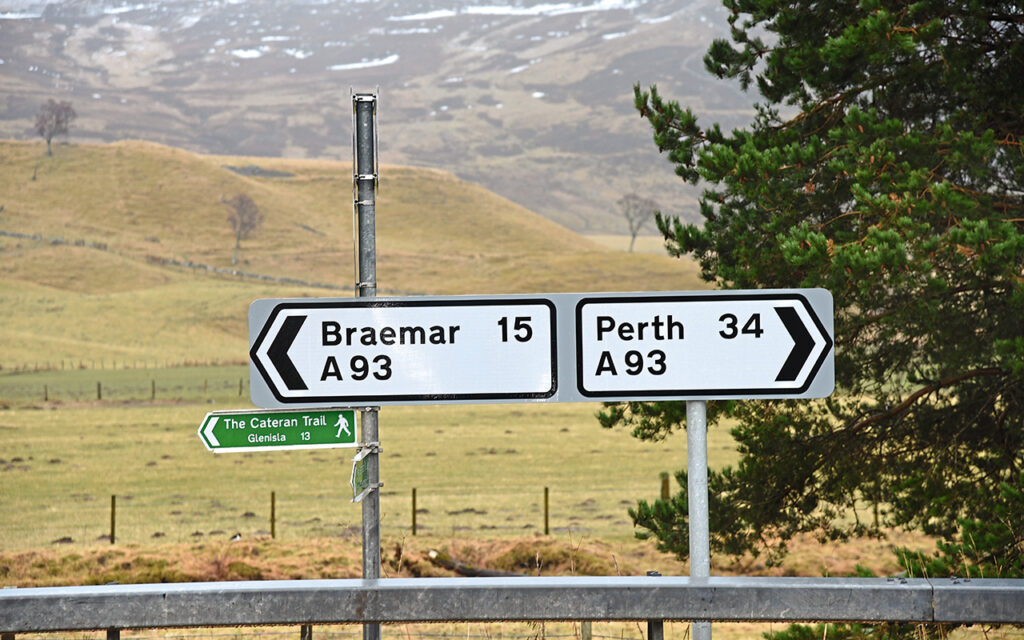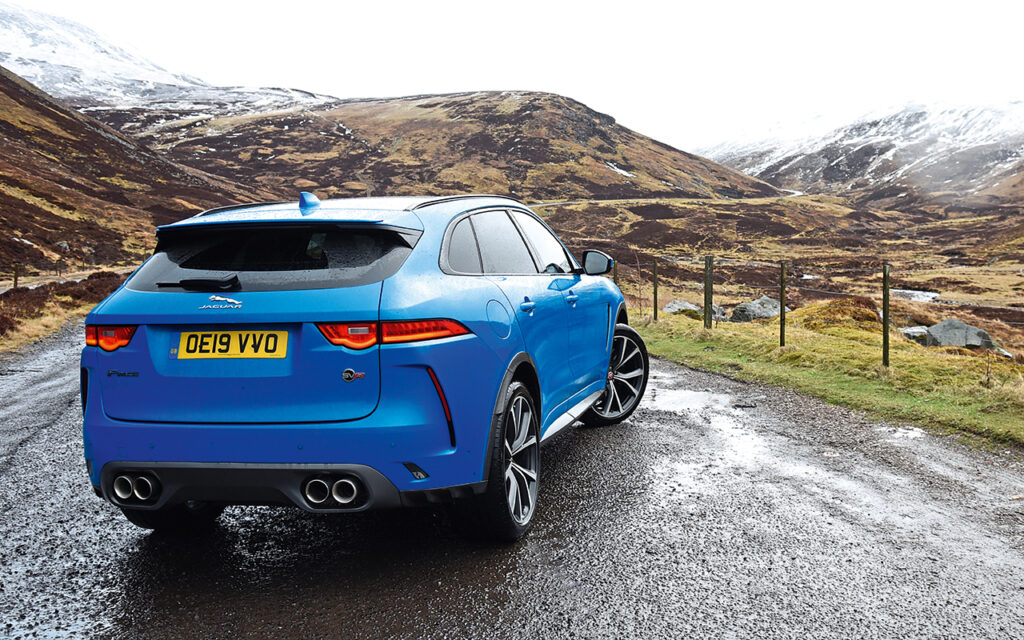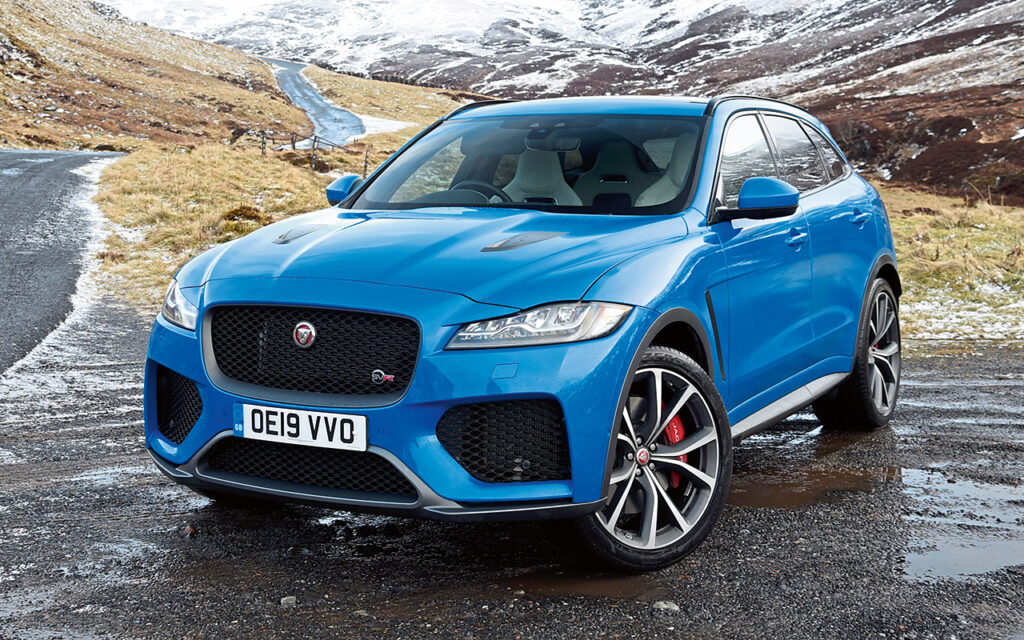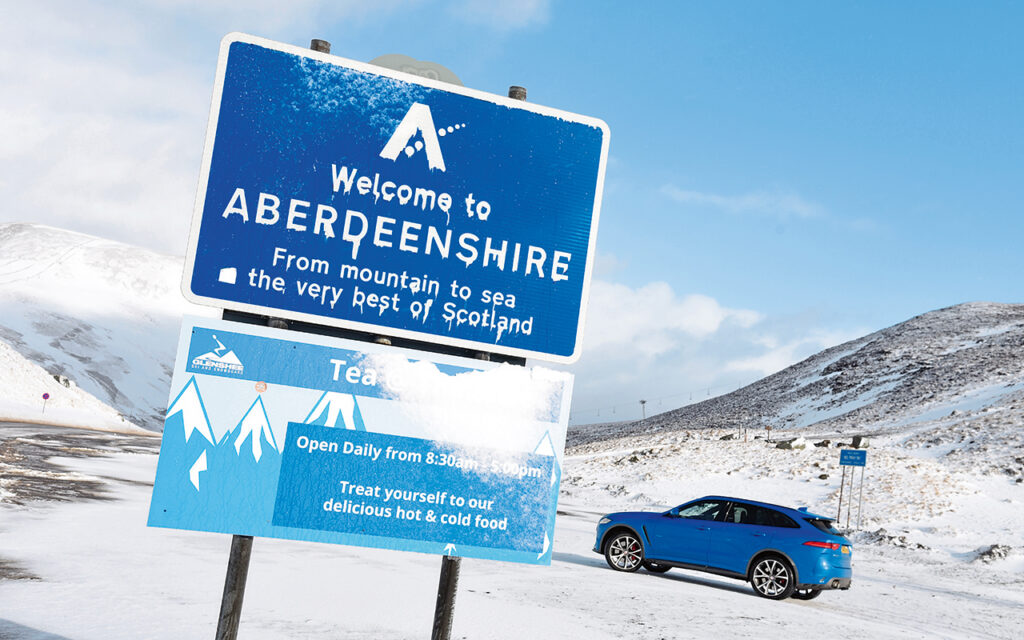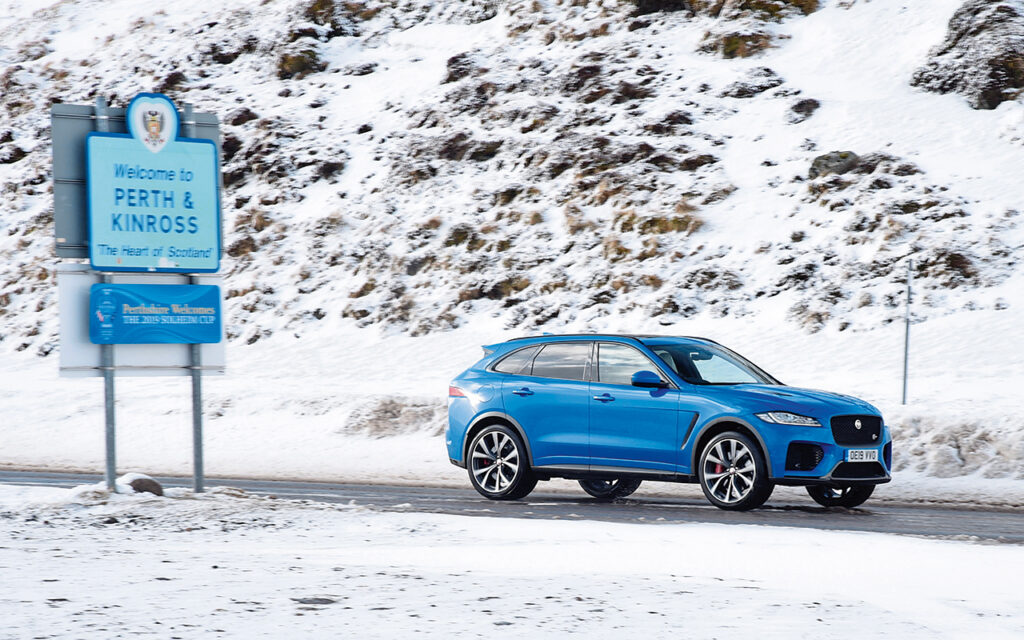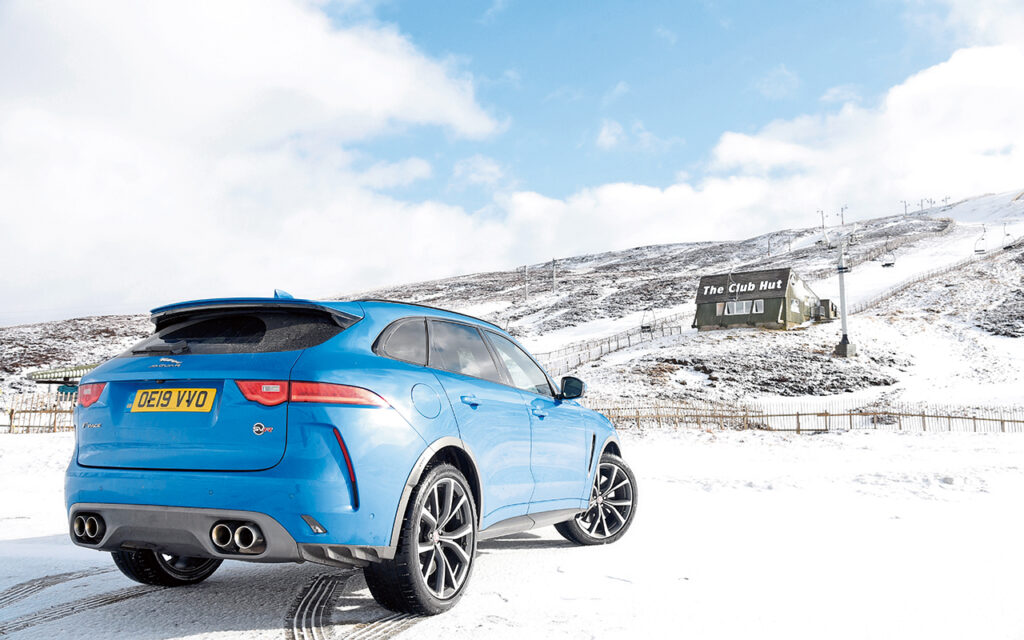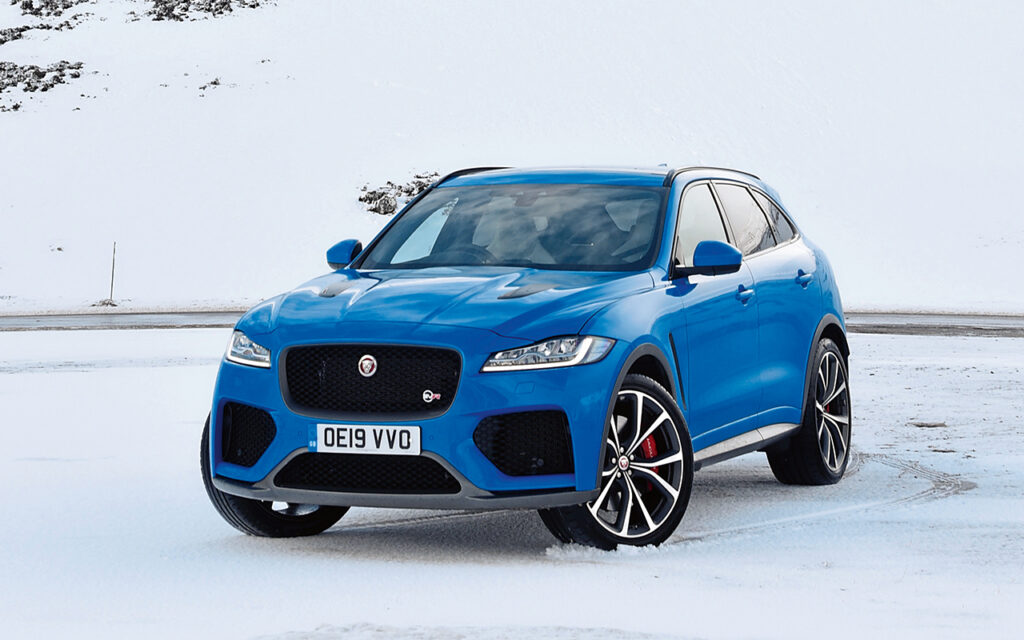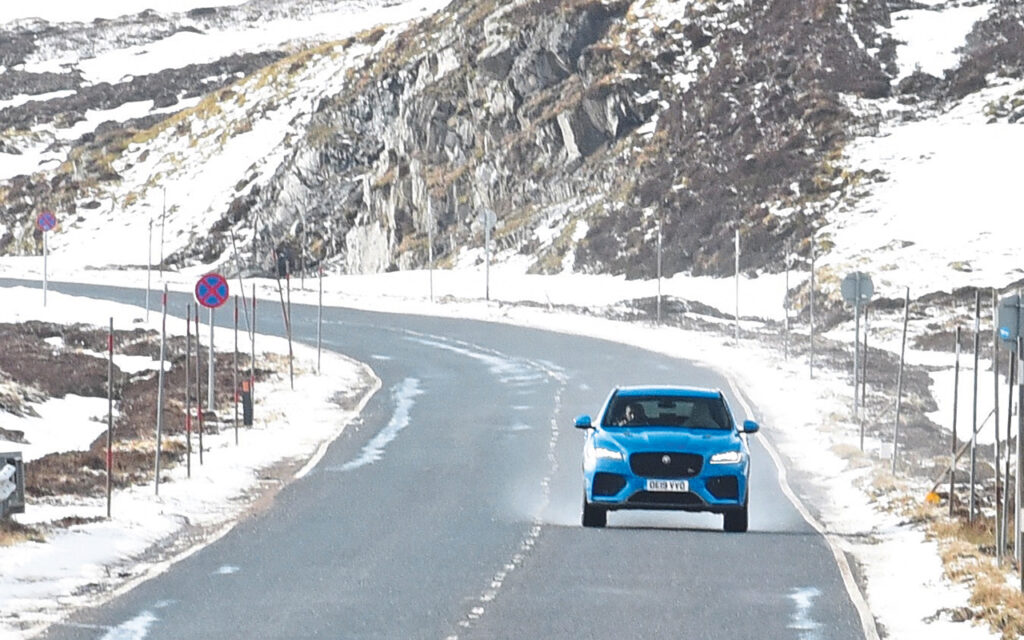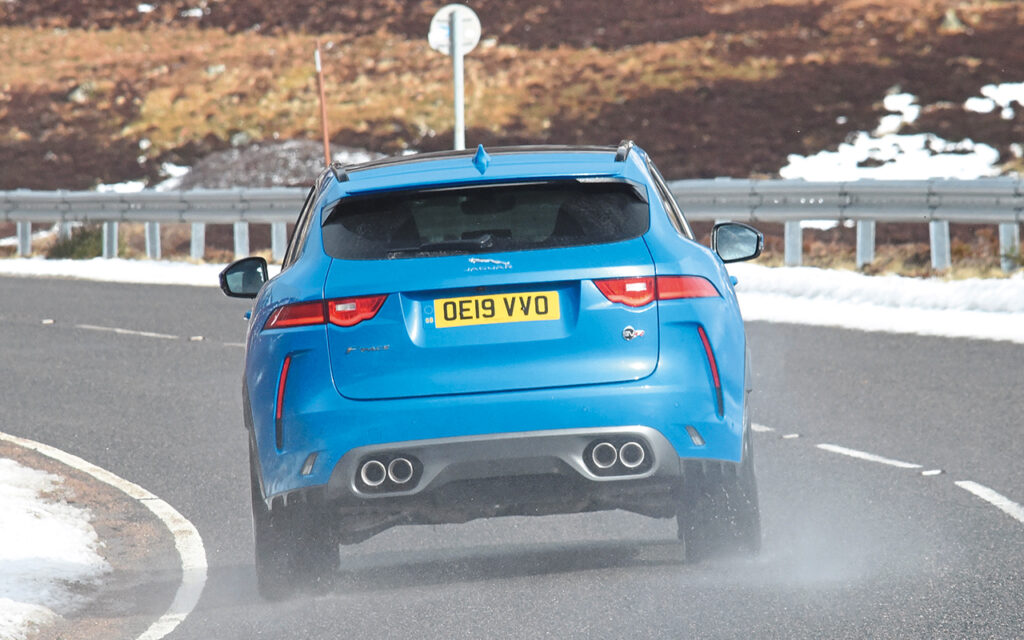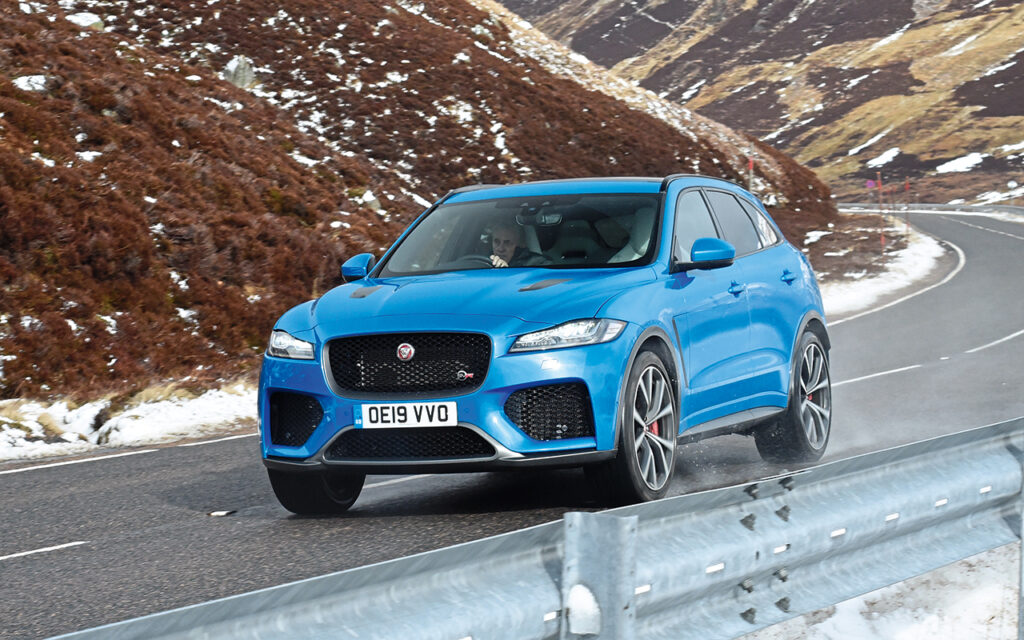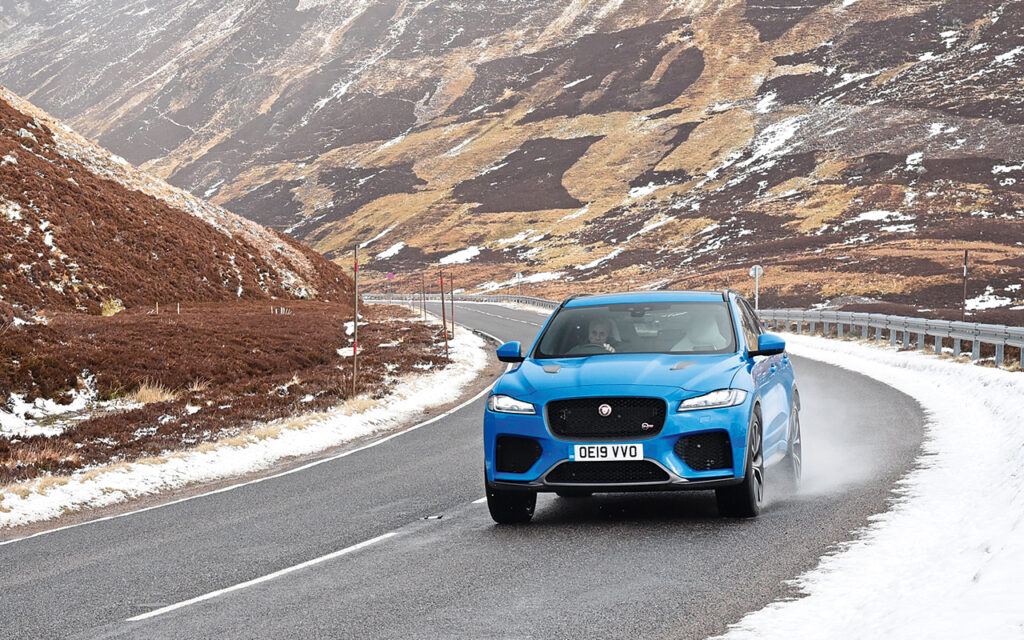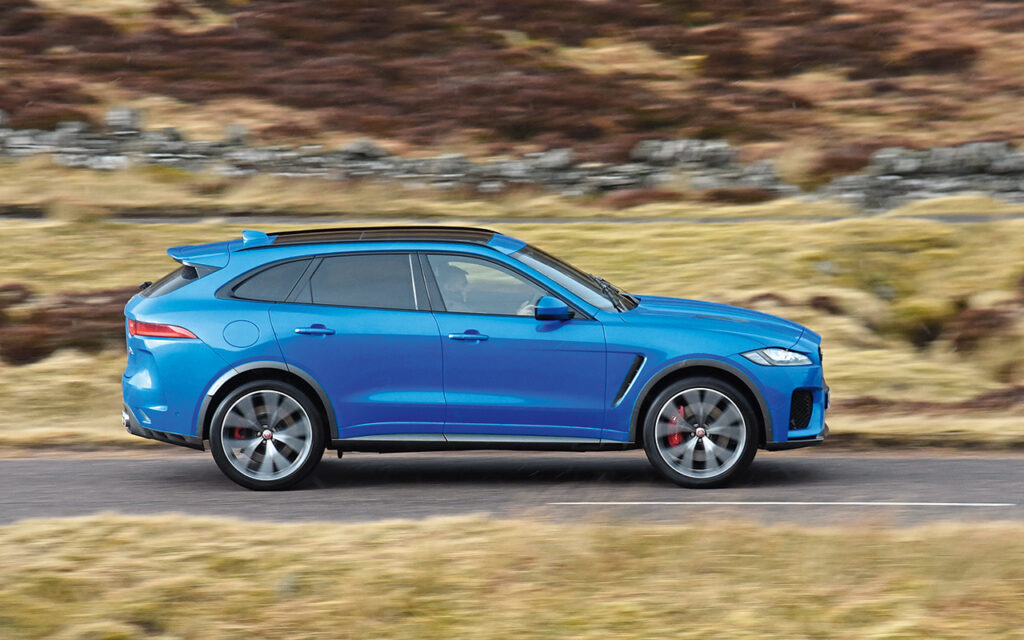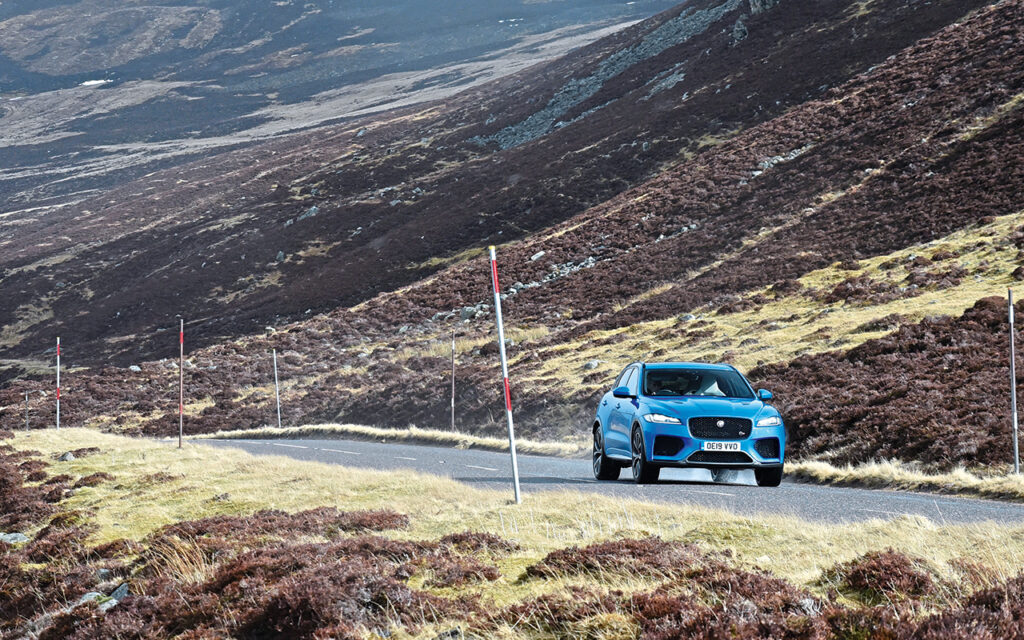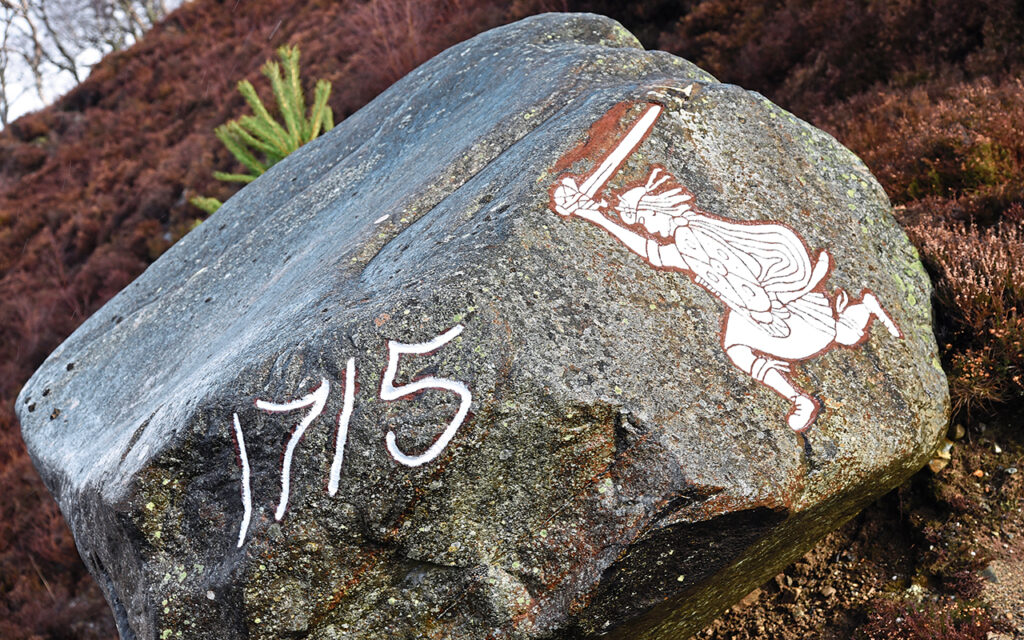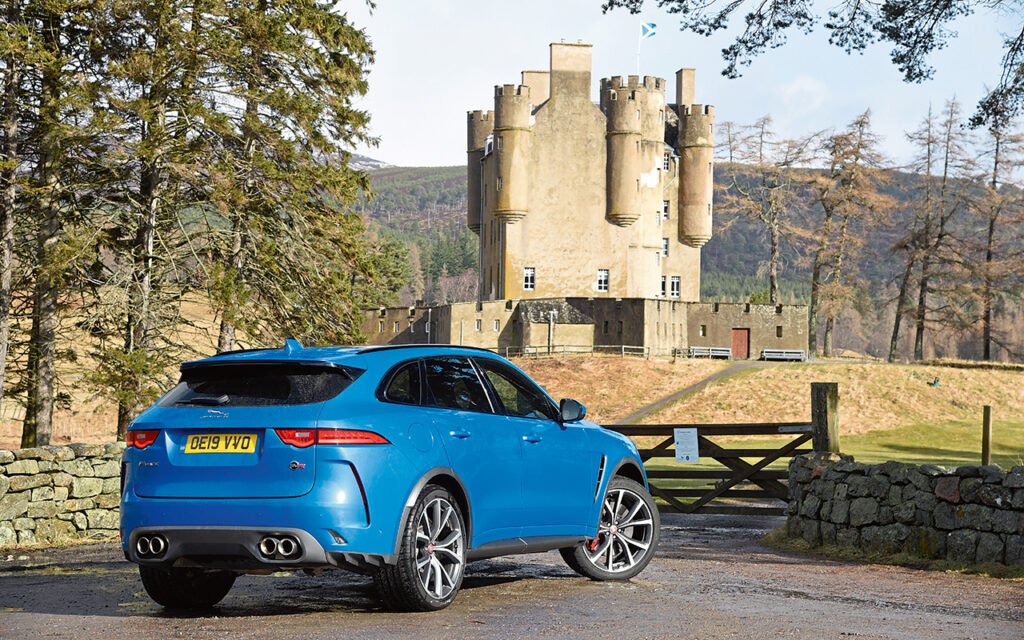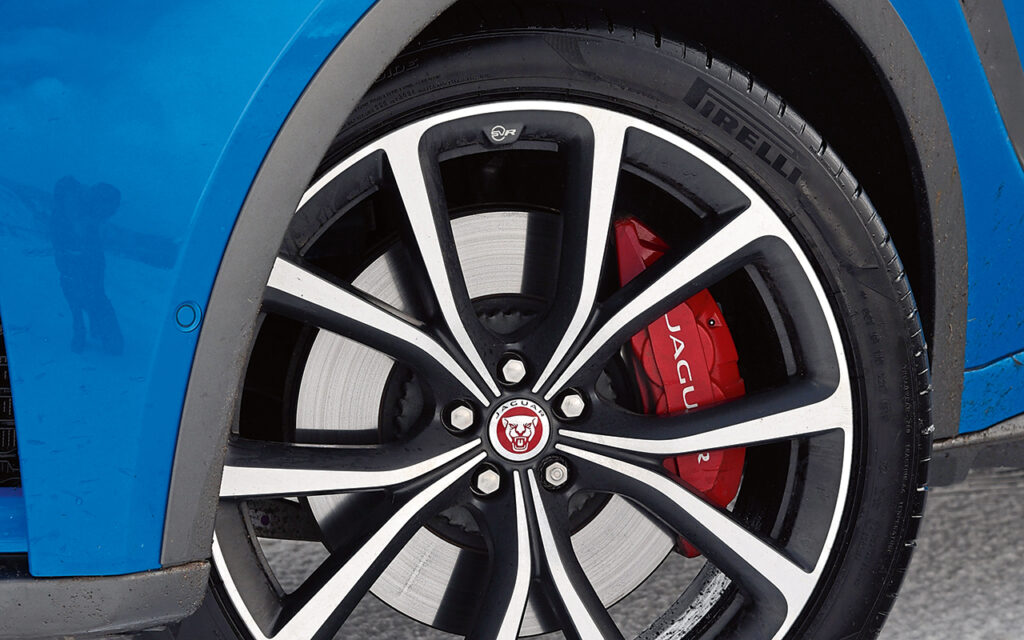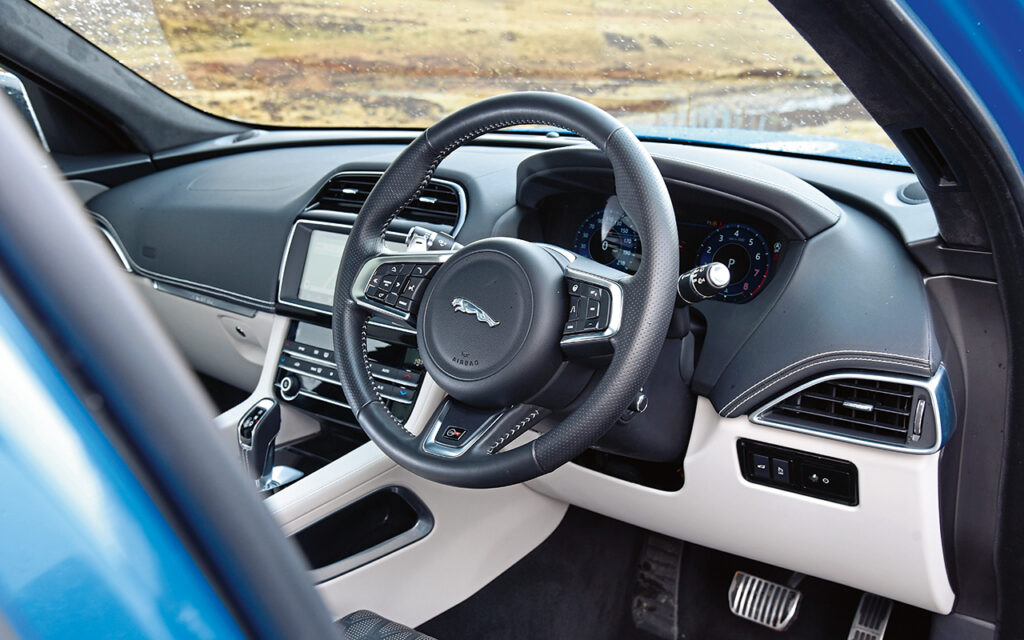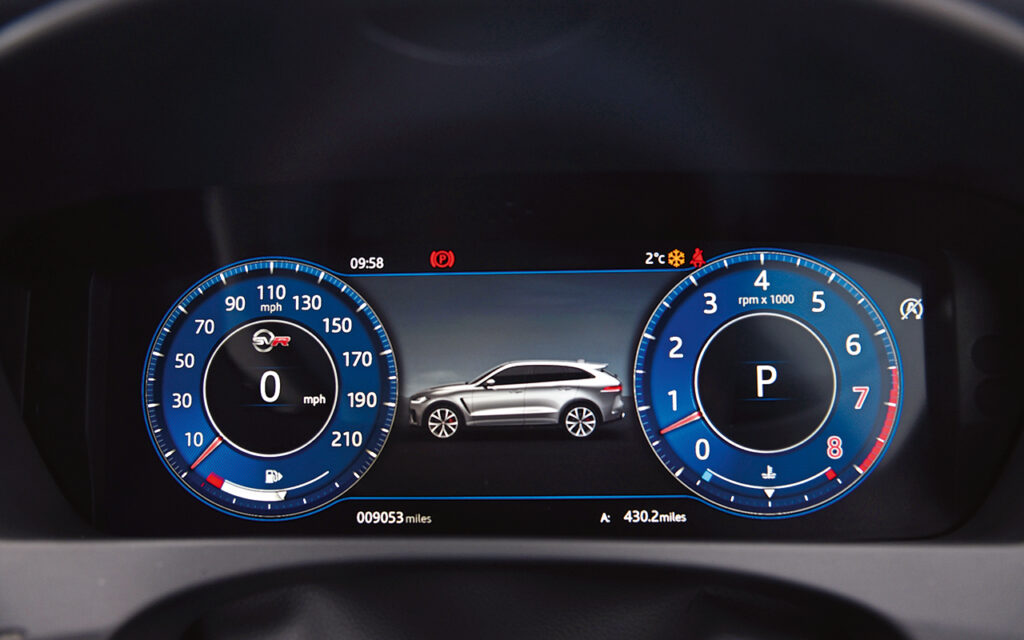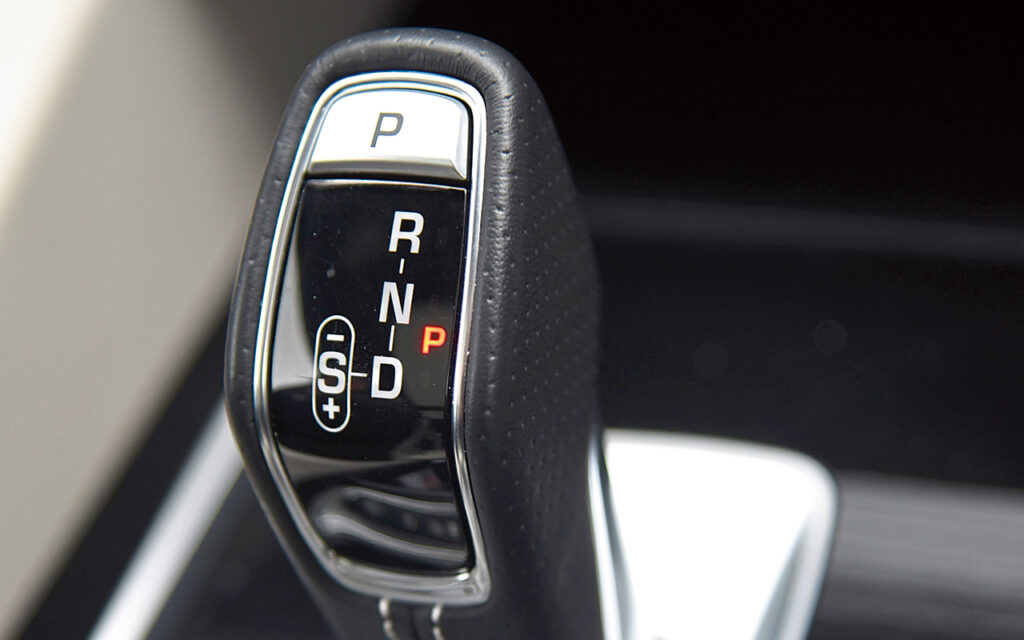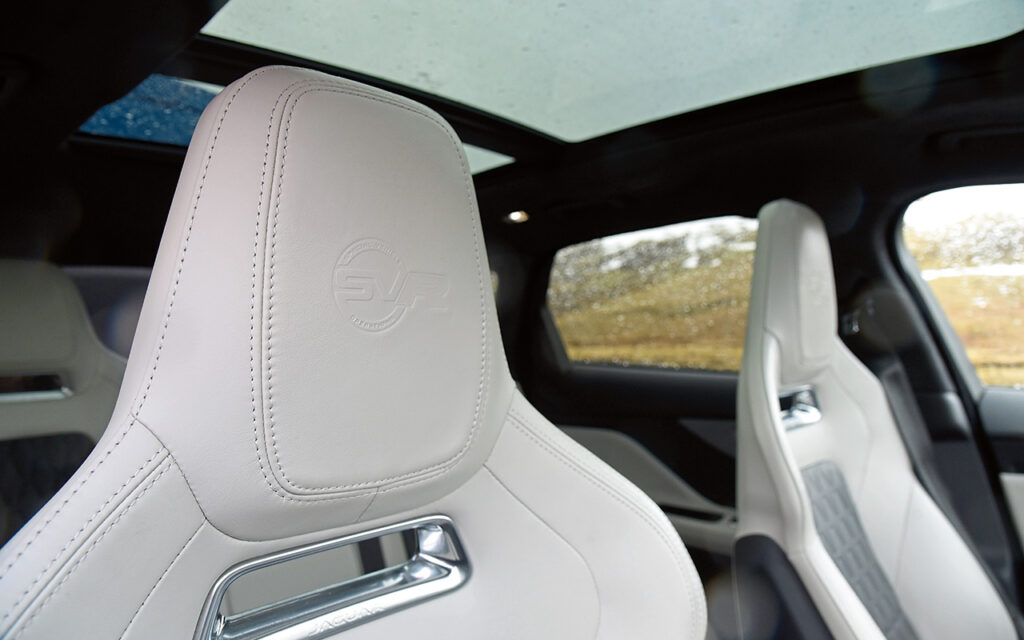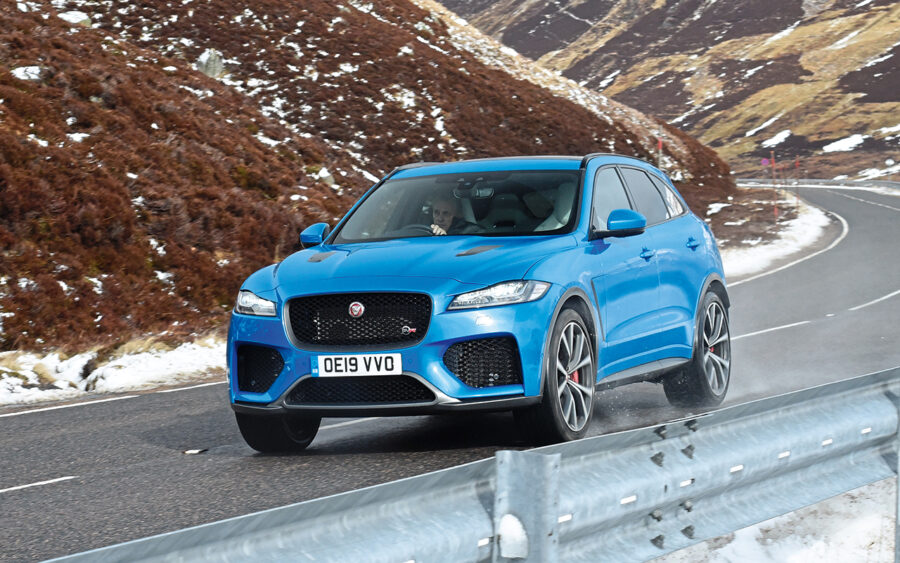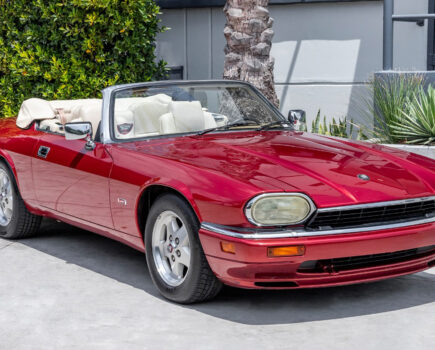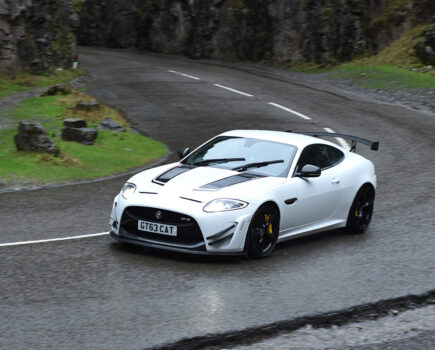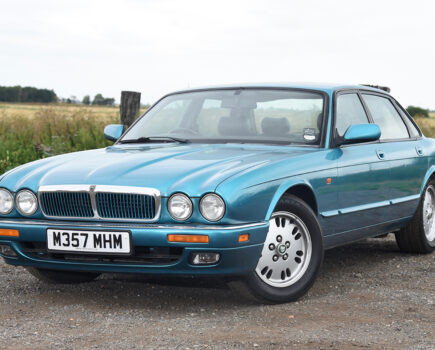We head to the UK’s highest road, Cairnwell Pass in the Scottish Highlands, to try out Jaguar’s fastest SUV – the F-Pace SVR
Words: Paul Walton
It’s only ten miles long but at 670m above sea level, the Cairnwell Pass in the Scottish Highlands features some of the most demanding driving conditions this country has to offer. Here, you’ll find uneven surfaces, slow bends, fast corners, hidden dips and even thick snow. There are also long straights, steep inclines and – perhaps most dangerous of all – skiers. In other words, the UK’s highest road is the perfect place to test the Jaguar’s fastest and most powerful SUV, the F-Pace SVR. But first, I have to get there.
Almost 500 miles from London, the Cairnwell Pass is in one of the most isolated parts of the British Isles, so even reaching it is an adventure. And with a spacious and comfortable (if dated) interior, any variety of F-Pace is an ideal car for the job; the SVR, with its 5.0-litre, 550PS (543bhp) supercharged V8 just makes it more interesting. The car makes short work of the A1 and M6, offering smooth, instant acceleration, plus lots more when I need it, and I soon zoom across the border into Scotland. Yet while the SVR’s ride is smooth on the motorway, as I find out later, the lowered and stiffened suspension isn’t keen on uneven surfaces.
The SVR isn’t what you’d call economical and, averaging 20mpg, I need to refuel shortly after the border. Looking back, I probably shouldn’t have played so many games of, What’s the lowest reading I can get for fuel economy by accelerating hard? The winning figure was a bank-draining 3mpg. Three? My lawn mower does better than that.
Eight hours, several coffees and a tank-and-a-half of unleaded later, I arrive at my hotel in Perth. Here, the car’s bright Ultra Blue stands out against the traditional granite Scottish buildings. I’m glad the car isn’t white; the coronavirus outbreak is just beginning and I wouldn’t want to look like I am with the United Nations; I don’t think my small bottle of hand sanitizer is enough to go around the town.
I leave the next morning to drive the Cairnwell Pass section of the A93 that links Perth with Aberdeen, 107 miles away. En route is Scone Palace, an ancient coronation site of Scottish kings and not, as I discovered at some considerable embarrassment, a giant sweet bread bun.
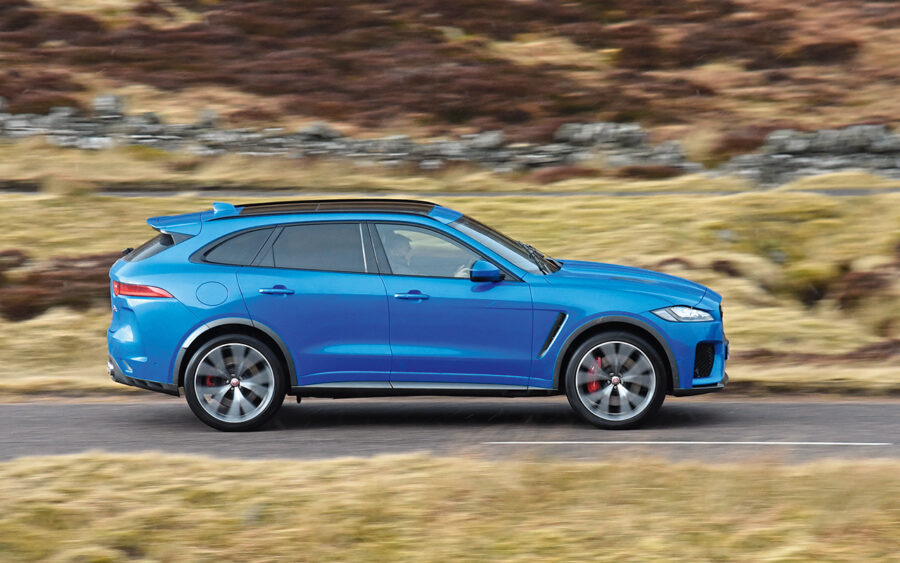
The Cairnwell Pass starts at the now-bypassed Spittal of Glenshee village and follows the military route that was built by Scotland’s Inspector of Roads, Major William Caulfeild, in the 1750s during the Jacobite Rebellion – and later used by drovers to take cattle and sheep to market. It was during the early 1900s, with the coming of the railway to Royal Deeside, that the road route to Aberdeen was completed. Some of the original road at Spittal of Glenshee – such as a beautiful, ancient stone bridge over the Shee Water – remains, as it does in other places.
Turning left out of the village I am immediately confronted by the Cairngorms, a mountain range that dominates the scenery how I imagine the New York skyline might as a mirage in the desert. The road is also perfectly straight, so I’m able to squeeze the throttle hard.
The V8 wakes up the moment I ask for more power, arriving in one long linear stream. Although fast – 60mph is reached in just 4.1 seconds – it’s not as bombastic as the 2011 XKR-S that shares the same 5.0-litre engine. The F-Pace’s all-wheel drive obviously adds stability, making it less tail happy, plus, in this application, the engine lacks the immediate and uncontrollable surge that it does in the R-S. Also, that deep, baritone growl from the active exhaust is not as embarrassing – or as police-attracting – as the XKR-S and most other recent, supercharged Jaguars. With its sensible boot and room for five, it makes the F-Pace SVR a performance Jaguar for grown-ups.
A few miles out of Glenshee, there’s the Devil’s Elbow: a double-hairpin made trickier on account of it being a one-in-six gradient. Notoriously hard to traverse, it was bypassed by the current straighter road in the 60s, much to the relief of everyone who used the road regularly. The Elbow still exists, but is, disappointingly, locked behind a gate and today can only be used by hardy cyclists. Pity; in this car it would have been fun.
The road starts to climb steeply now, the few patches of snow on the hills growing until they join together at the summit to create a thick blanket covering everything as far as I can see.
When I first tested the F-Pace SVR I said the car was a grand tourer in the same mould as the XJR-S and XKR. Thanks to its large engine, refinement and comfort, I stand by that statement.
But it’s also an SUV, so as well as all-wheel drive, it has Jaguar’s clever All Surface Progress Control and Adaptive Surface Response systems for when things get tricky. Of course, I’m not sure how the admittedly beautiful lightweight alloy wheels (21in at the front, 22in at the rear) that are shod with rubber-band-thin road tyres would cope if I were to head into the desolate moorland, but, as I wade through the snow – turned into a yucky brown slush by the gritter lorries that constantly head up and down the mountain – the big car feels confident, the four wheels finding grip where there’s little grip to be had. The XKR-S might be faster, but I’d be in a ditch by now.
The Cairnwell Pass is not quite the rooftop of the UK – Ben Nevis, 110 miles to the west, takes that accolade at 1,435m (4,413ft) – but it’s certainly on one of the upper floors at 670m (2,199ft). Even at this height, the Cairngorm peaks still tower over me, pure white, like a multi-tiered wedding cake, making me feel small and insignificant. But also hungry. I like cake.
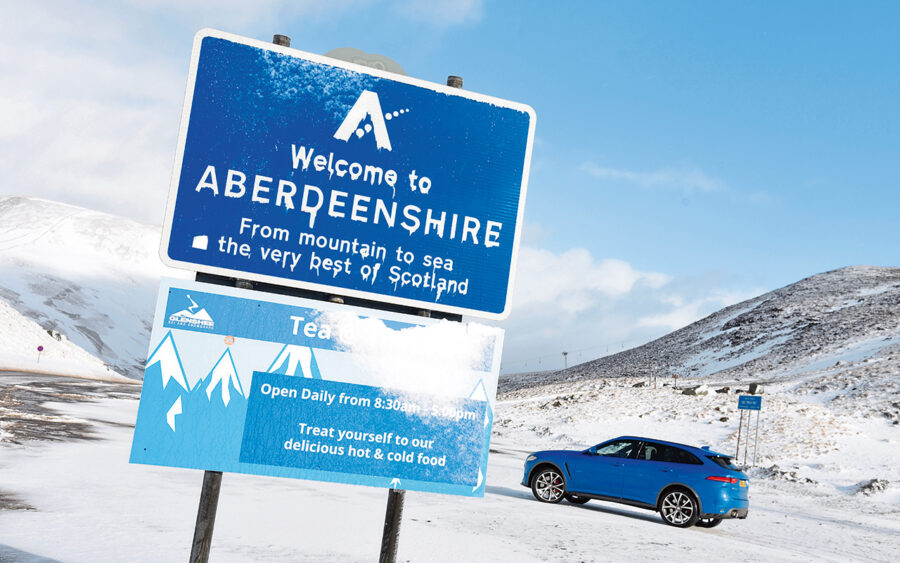
As soon as the pass starts to plateau, it crosses from Perthshire into Aberdeenshire, one of the UK’s most northerly counties. The scenery is majestic, but also bleak, and I feel alone, as though I were the only person around, hundreds of miles from civilisation and, even worse than that, a decent coffee. And then, I stumble across the Glenshee Ski & Snowboard Centre. Covering 2,000 acres with 22 lifts and 22 miles of pisted runs, it is Britain’s largest and oldest snow sports resort. Even though it’s a Wednesday, the centre is also the busiest, and endless begoggled skiers of all ages are crossing the road to the slopes. To see so many people in such an empty part of the world seems as unlikely as discovering an open McDonalds during the apocalypse.
A sudden blizzard whips across the road, totally obscuring the view as if we are in a shaken snowglobe. I pull over to wait for it to pass; there are much worse places to be. With heated seats, heated steering wheel and a DAB radio, it’s better specified than my house.
As I indicated earlier, the F-Pace’s interior is now quite old fashioned. The ventilation controls, for example, look dated, although they’ll probably be replaced by the same digital readout of the I-Pace and now XE. And some of the plastic trim looks and feels cheap and badly moulded. But the SVR’s lozenge-quilted, leather performance seats and SVR-branded steering wheel help to make the car worthy of its £75k price tag. There’s no denying that’s a big chunk of money, but considering it’s £30k less than the outgoing F-Type SVR and £25k cheaper than the current Range Rover Sport SVR, it’s actually good value.
With the frenzied blizzard leaving as quickly as it arrived, and the road mercilessly clear thanks to all that salt, I’m able to put my foot down for a following long straight, giving the skiers an insight into what a blast of 550PS sounds like.
Then, after a long, fast bend, the road starts to descend, the snow immediately disappearing to reveal the brown moorland below. With its many fast corners, this side of the mountain is like a Scottish Stelvio Pass and is a real test for the supercharged SUV, but it’s soon obvious that this car is more than capable. As a corner fast approaches, I change down using the aluminium steering wheel-mounted paddles (as nice to touch as the controls on an expensive Bang & Olufsen stereo), the ZF eight-speed gearbox reacting immediately to my demand.
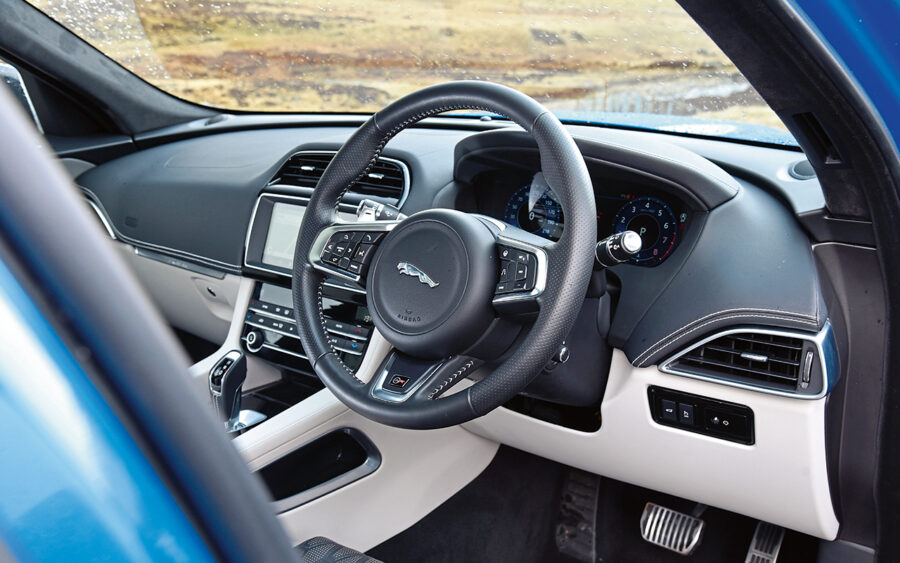
With the torque perfectly balanced, I start to thread through the bend. Uprated dampers, with front and rear spring rates increased by 30 and ten percent, respectively, the big F-Pace SVR is remarkably nimble, its steering fast and accurate, and shows remarkably little body roll. At the bend’s apex I nail the throttle, the engine responding instantly, resulting in a flood of addictive power as well as a sinister growl in the cabin.
The transformation from off-roader to sports car is remarkable, but it’s not perfect. On uneven and loose surfaces, the lowered suspension and low-profile tyres give a ‘squirrelly’ feel, a technical term for the steering needing constant slight correction.
The road descends quickly and, now outside Braemar, I pass the image of Scottish soldier carved into rock, displaying the date 1715. My first thought is that it’s a very exact time for when the road was built, but it honours the spot where James Stuart’s standard was raised, marking the start of the Jacobite Rebellion. (In reality, the flag was raised a few yards away, at the point where the impressive Invercauld Hotel now stands. A brass plaque inside one of the rooms celebrates this.)
I head down into Braemar, a pretty village that symbolises the end of the Cairnwell Pass and is now famous for its imposing 17th century castle, and for being the third-coldest low-lying place in the UK.
Although the distance between Glenshee and Braemar is just ten miles, the Cairnwell Pass is still one of the most stunning, magnificent and demanding roads to be found anywhere in Europe. Its incredible scenery and changeable conditions would have been enjoyable in any car, even my own £500 X-Type (although all that salt would have made it fall apart quicker than the supermarket’s shelves are currently being cleared of loo rolls and pasta), but driving the F-Pace SVR was phenomenal. It might not be the perfect car, but it was the perfect choice to tame this unparalleled high road.
